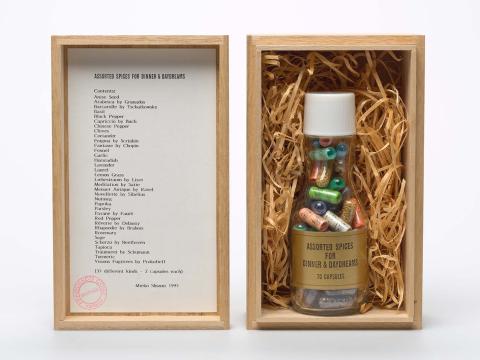ESSAY: Mieko Shiomi: The world as a process
By Reuben Keehan
‘We Can Make Another Future’ September 2014
Like several of the artists associated with Fluxus, Mieko Shiomi trained as a musician, graduating from the Tokyo National University of Fine Arts and Music in 1961. While still a student, Shiomi established Group Ongaku, an experimental circle of musicians and friends, who explored improvisation and concrete sound compositions using found objects (dishes, egg beaters and kitchenware), altered instruments and the human voice. Much of their experimentation aligned with the event scores and actions of Fluxus artists working in New York at the time, and in 1964 Shiomi travelled to New York where she met George Maciunas, Dick Higgins, Alison Knowles, Nam June Paik and Ay-O, and participated in Fluxus performance events and concerts.
Spatial Poem No. 1 1965 was the first ‘word event’ piece to emerge from Shiomi’s involvement with the New York Fluxus group. The work captured the international scope of Fluxus activity by inviting 80 participants from around the world (by mail) to perform the following simple event and write a report to send to the artist — ‘Write a word or words on the enclosed card and place it somewhere. Please tell me the word and its place, which will be edited on the world map’. When the artist returned to Japan in 1965, the work evolved into a series of further word events, which elaborated on the disparate, incidental nature of her practice; Shiomi then continued her Spatial Poem project into the 1970s.
On her return to Japan, Shiomi’s work increasingly engaged with the subtle, ephemeral rhythms of the natural world. Water, wind, light and shadows became the material of her scored events, such as Water music 1965, which drew attention to the ordinary flow of events and change in everyday life. Like other women associated with Fluxus, such as Alison Knowles, Yoko Ono, Takako Saito, Alice Hutchins and Charlotte Moorman, Shiomi was using action to potentially liberate human experience from conventional industrial, consumerist and socially restrictive patterns of apprehending reality. Such events and actions were intended to prompt a viewer’s or performer’s attention to the incidental — to pause, take notice, slow down.
An incidental story on the day of a solar eclipse #1, #2, #3 1995 is a three-part work which crystallises recurring elements of Shiomi’s practice, including a concern with light, shadow and the transition between appearing and disappearing. A solar eclipse is paired with a poetic, alliterative text, which takes the viewer through a series of dreamlike events accompanying the playing of Bach’s partitas. The interplay of music, light, time, dreaming and a child-like wordplay — materialised in three transparent sheets of paper — embraces the playfulness, fascination with language and the ephemerality characteristic of Fluxus activities and multiples.
By the 1990s, several museum Fluxus surveys had been mounted and, at this time, Shiomi revisited and reinterpreted earlier works, events and ideas in light of this renewed interest, particularly from a younger generation of Japanese artists. The Fluxus balance (portfolio) 1993 repurposes Shiomi’s Spatial Poems into a kind of card or board game in which printed cards containing descriptions of an object, an idea, event instructions or concepts — contributed by participants from around the world — are considered by the player in terms of their conceptual balance. The FluxAtlas component of the portfolio is a reprinted version of Shiomi’s Spatial Poem No. 2, first published by George Maciunas in 1966, in which selected participants were asked to record what they were doing at a certain time and date and the direction they were facing; this information was then plotted on a map. Similarly, Shiomi’s Assorted spices for dinner & daydreams 1995 recalls the familiar format of ‘Fluxkits’ and boxes published by Maciunas. With capsules containing ‘spices’ and scrolled musical scores, the work invites the user to participate in ordinary activities with perhaps a heightened sense of significance through the addition of these condiments.
Of all the Fluxus artists, it is perhaps Mieko Shiomi’s art that comes closest to American avant-garde composer John Cage’s idea: ‘The world, the real is not an object. It is a process’.1
Endnote
- John Cage, in Joan Rothfuss, Elisabeth Armstrong, Janet Jenkins (eds), In the Spirit of Fluxus [exhibition catalogue], Walker Art Center, Minneapolis, 1993, p.66.
Connected objects

Fluxus balance (portfolio) 1993
- SHIOMI, Mieko - Creator
Related artists
SHIOMI, Mieko
1938
- present
Full profile
for SHIOMI, Mieko
Metadata, copyright and sharing information
About this story
- Subject

